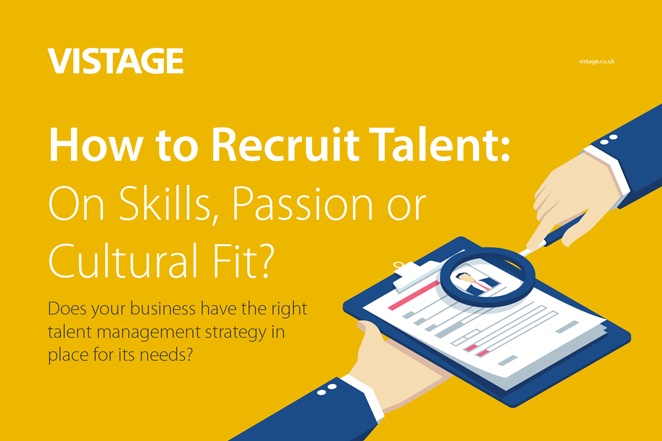
[SCROLL DOWN FOR OUR INFOGRAPHIC]
Film director Jim Jarmusch said a project can be fast, good or cheap - but you have to pick two.
With recruitment, you’re lucky if you get to pick one. In-house recruitment costs an average of £4,800 per head, and agencies bring that average cost up to £8,800, for SMEs, it’s certainly not cheap. On average, 10-12 weeks elapse between job opening and accepted offer (rising to 12-16 weeks for in-house operations), so it’s definitely not fast. Meanwhile, 70% of in-house operations fail to fill every position that’s open, so even ‘good’ is debatable.
There’s no catch-all formula to fix recruitment, although it helps to understand your demand, budget accordingly and make contacts in training institutions. Before you consider the practicalities, though, you must know for sure what you’re looking for.
What are your priorities in a new hire? Raw talent, passion and drive, or the right fit for your workplace culture - all of the above, or something else?
Talent
If you’re selecting on talent, you’re looking for a strict match between the job description, the person spec, and the CV. Your ideal candidate has all the skills you’re looking for.
They should also have the core soft skills that aren’t taught in schools, on placements or at university: critical thinking, adaptability, learning agility and communication. Their interview performance is just that - a performance. It’s studied, well prepared, and flush with anecdotes which prove their competence at handling major change, big decisions and team relationships.
They’re highly professional and career-driven - but they’re not exactly loyal. If a better offer comes along, they’ll probably take it. Securing these people relies on a competitive “employee experience”.
According to Google Trends data, this term has appeared more and more frequently in job searches since 2004, particularly in the UK, the US and India. LinkedIn’s Global Recruiting Trends survey suggests this means employees are expecting quality of life perks - free lunches, flexible work hours, health plans and plenty of breaks.
This is especially true in high-demand sectors. In IT, particularly in cybersecurity, there are more skilled roles than skilled people. The increasing complexity of these roles - some require PhD-level cryptography, mathematics or physics - means talent has to be tempted out of academia with a premium package.
Passion
The passionate recruit may not have the same body of evidence to prove their skills, but they’re keen to learn. They want to work - and often, they’re particularly drawn to that specific role with your specific business.
However, there’s a strong argument against passion as a desired trait in employees, something you place front and centre in your recruitment process. A Gallup World Poll claims only 15% of employees in the entire world are engaged in their work, let alone positive about it.
Passion, it’s claimed, is unsustainable. Loving something is not the same as being good at it; some aspects of the job are dull, difficult, or dangerous, to the point where we question if someone can truly be passionate about them.
The FT suggests a cool, detached ‘like’ for the job is more viable than an infatuation - not to mention a more realistic expectation on your part. Robert Howard of Baker College, Michigan's largest, private, not-for-profit university, suggests ‘passion’ should be read as ‘integrity and grit’ - a strong, unwavering commitment to the team and the role. Paul Smith, keynote speaker and author of the … with a Story manuals, claims that passion - whatever it means - depends on the story you tell, and so you can build your recruitment process to evoke and develop it as you’re going along.
Cultural fit
Cultural fit is the glue that holds a team together, and the machine that makes your business strategy succeed or fail. A recruit who fits the culture aligns their values and behaviours with those that exist in your company - or those that you’re trying to create by hiring them.
Here’s why it’s important: 86% of hires fail due to poor cultural fit, 50% of employee engagement stems from cultural fit, and companies with engaged employees perform twice as well as competitors without them. It doesn’t matter how talented and passionate a recruit is; if they don’t fit in with the team, or the business as a whole, they end up holding you back and costing you money. On average, you’ll spend a fifth of their salary and three months of your time on replacing them.
Cultural fit is demonstrated by the same soft skills we described above. Employees with good interpersonal skills, creative approaches and emotional intelligence are able to read a new work environment and adapt their behaviour to suit it.
This adaptability benefits your company on the strategic level, too. Jeff Boss (author of Navigating Chaos and host of the ChaosCast podcast) says “companies don’t fail because of changes in the market or society; they fail because the people in them don’t adapt to those changes.” Recruiting for cultural fit means you’re building up a team who can handle change.
The right way
The right way
So - which one do you prioritise? It’s a trick question.
Attracting and retaining skilled talent is difficult, but you need people who can do the job - so you need to offer incentives that will bring them on board and keep them loyal.
Employee retention also depends on cultural fit - you need someone who can adjust to the way your business does things, and adapt to new processes when necessary.
Finally, you need your employees to be engaged - and it helps if they at least like their job, and are committed to doing it with integrity and determination, so you need to sound out and build that passion.
Hiring has to be focused on your overall goals and values. Know yourself, and your business, and you’ll know what to look for when you’re building your talent management strategy.
More from Vistage:


